
Odenwald
Encyclopedia

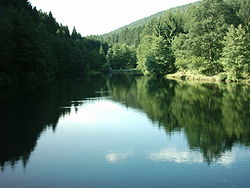
Hesse
Hesse or Hessia is both a cultural region of Germany and the name of an individual German state.* The cultural region of Hesse includes both the State of Hesse and the area known as Rhenish Hesse in the neighbouring Rhineland-Palatinate state...
, Bavaria
Bavaria
Bavaria, formally the Free State of Bavaria is a state of Germany, located in the southeast of Germany. With an area of , it is the largest state by area, forming almost 20% of the total land area of Germany...
and Baden-Württemberg
Baden-Württemberg
Baden-Württemberg is one of the 16 states of Germany. Baden-Württemberg is in the southwestern part of the country to the east of the Upper Rhine, and is the third largest in both area and population of Germany's sixteen states, with an area of and 10.7 million inhabitants...
in Germany
Germany
Germany , officially the Federal Republic of Germany , is a federal parliamentary republic in Europe. The country consists of 16 states while the capital and largest city is Berlin. Germany covers an area of 357,021 km2 and has a largely temperate seasonal climate...
.
Location
| Location |
|---|
 |
The Odenwald lies between the Upper Rhine Rift Valley with the Bergstraße and the Hessisches Ried (the northeastern section of the Rhine rift) in the west, the Main and the Bauland (a mostly unwooded area with good soils) in the east, the Hanau-Seligenstadt Basin
Hanau-Seligenstadt Basin
The Hanau-Seligenstadt Basin is a subbasin of the Upper Rhine Graben southeast of Frankfurt am Main .- Location :The Hanau-Seligenstadt Basin is located in the eastern part of the Lower Main lowlands. The river Main crosses the basin between Aschaffenburg and Offenbach am Main...
– a subbasin of the Upper Rhine Rift Valley in the Rhine-Main Lowlands – in the north and the Kraichgau
Kraichgau
The Kraichgau is a hilly region in Baden-Württemberg, southwestern Germany. It is bordered by the Odenwald and the Neckar to the North, the Black Forest to the South, and the Upper Rhine Plain to the West. To the east, its boundary is considered to be the Stromberg, the Hardt, and the...
in the south. The part south of the Neckar
Neckar
The Neckar is a long river, mainly flowing through the southwestern state of Baden-Württemberg, but also a short section through Hesse, in Germany. The Neckar is a major right tributary of the River Rhine...
valley is sometimes called the Kleiner Odenwald (“Little Odenwald”).
The northern and western Odenwald belong to southern Hesse, with the south stretching into Baden
Baden
Baden is a historical state on the east bank of the Rhine in the southwest of Germany, now the western part of the Baden-Württemberg of Germany....
. In the northeast, a small part lies in Lower Franconia
Lower Franconia
Lower Franconia is one of the three administrative regions of Franconia in Bavaria , Germany ....
in Bavaria.
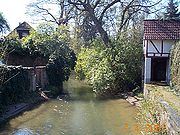


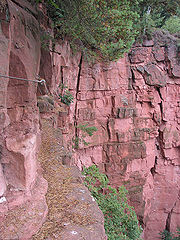
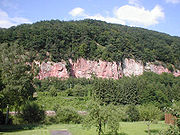
Geology
The Odenwald, along with many of Germany’s low mountain ranges, belongs to the VariscanVariscan orogeny
The Variscan orogeny is a geologic mountain-building event caused by Late Paleozoic continental collision between Euramerica and Gondwana to form the supercontinent of Pangaea.-Naming:...
, which more than 300,000,000 years ago in the Devonian
Devonian
The Devonian is a geologic period and system of the Paleozoic Era spanning from the end of the Silurian Period, about 416.0 ± 2.8 Mya , to the beginning of the Carboniferous Period, about 359.2 ± 2.5 Mya...
ran through great parts of Europe
Europe
Europe is, by convention, one of the world's seven continents. Comprising the westernmost peninsula of Eurasia, Europe is generally 'divided' from Asia to its east by the watershed divides of the Ural and Caucasus Mountains, the Ural River, the Caspian and Black Seas, and the waterways connecting...
. The cause of this orogeny
Orogeny
Orogeny refers to forces and events leading to a severe structural deformation of the Earth's crust due to the engagement of tectonic plates. Response to such engagement results in the formation of long tracts of highly deformed rock called orogens or orogenic belts...
was the collision of Africa
Africa
Africa is the world's second largest and second most populous continent, after Asia. At about 30.2 million km² including adjacent islands, it covers 6% of the Earth's total surface area and 20.4% of the total land area...
’s and Europe’s forerunner continents.
In the Triassic
Triassic
The Triassic is a geologic period and system that extends from about 250 to 200 Mya . As the first period of the Mesozoic Era, the Triassic follows the Permian and is followed by the Jurassic. Both the start and end of the Triassic are marked by major extinction events...
, about 200,000,000 years ago, the land sank again, forming the so-called “Germanic Basin” in which the metre-thick layers of red sandstone could build up
Sedimentation
Sedimentation is the tendency for particles in suspension to settle out of the fluid in which they are entrained, and come to rest against a barrier. This is due to their motion through the fluid in response to the forces acting on them: these forces can be due to gravity, centrifugal acceleration...
. These were later covered over with layers of muschelkalk
Muschelkalk
The Muschelkalk is a sequence of sedimentary rock strata in the geology of central and western Europe. It has a Middle Triassic age and forms the middle part of the Germanic Trias, that further consists of the Buntsandstein and Keuper...
from a broad inland sea, then followed by sediments from the Late Triassic
Late Triassic
The Late Triassic is in the geologic timescale the third and final of three epochs of the Triassic period. The corresponding series is known as the Upper Triassic. In the past it was sometimes called the Keuper, after a German lithostratigraphic group that has a roughly corresponding age...
(or Keuper). The South German Cuesta
Cuesta
In structural geology and geomorphology, a cuesta is a ridge formed by gently tilted sedimentary rock strata in a homoclinal structure. Cuestas have a steep slope, where the rock layers are exposed on their edges, called an escarpment or, if more steep, a cliff...
Land thus formed.
When the land in the Odenwald was uplifted
Tectonic uplift
Tectonic uplift is a geological process most often caused by plate tectonics which increases elevation. The opposite of uplift is subsidence, which results in a decrease in elevation. Uplift may be orogenic or isostatic.-Orogenic uplift:...
again about 180,000,000 years ago, more than 100 m of the sedimentary layering, in parts, was eroded
Erosion
Erosion is when materials are removed from the surface and changed into something else. It only works by hydraulic actions and transport of solids in the natural environment, and leads to the deposition of these materials elsewhere...
away down to the bedrock
Bedrock
In stratigraphy, bedrock is the native consolidated rock underlying the surface of a terrestrial planet, usually the Earth. Above the bedrock is usually an area of broken and weathered unconsolidated rock in the basal subsoil...
, as can still be seen in the western Odenwald. The bedrock here is made out of a remarkably great number of different minerals, among them gneiss
Gneiss
Gneiss is a common and widely distributed type of rock formed by high-grade regional metamorphic processes from pre-existing formations that were originally either igneous or sedimentary rocks.-Etymology:...
, granite
Granite
Granite is a common and widely occurring type of intrusive, felsic, igneous rock. Granite usually has a medium- to coarse-grained texture. Occasionally some individual crystals are larger than the groundmass, in which case the texture is known as porphyritic. A granitic rock with a porphyritic...
, diorite
Diorite
Diorite is a grey to dark grey intermediate intrusive igneous rock composed principally of plagioclase feldspar , biotite, hornblende, and/or pyroxene. It may contain small amounts of quartz, microcline and olivine. Zircon, apatite, sphene, magnetite, ilmenite and sulfides occur as accessory...
, gabbro
Gabbro
Gabbro refers to a large group of dark, coarse-grained, intrusive mafic igneous rocks chemically equivalent to basalt. The rocks are plutonic, formed when molten magma is trapped beneath the Earth's surface and cools into a crystalline mass....
in the Frankenstein pluton
Pluton
A pluton in geology is a body of intrusive igneous rock that crystallized from magma slowly cooling below the surface of the Earth. Plutons include batholiths, dikes, sills, laccoliths, lopoliths, and other igneous bodies...
, and so on. In the eastern Odenwald, the red sandstone is all that is left of the sedimentary mixture. Farther east in the Bauland, the muschelkalk deposits still overlie the Early Triassic
Early Triassic
The Early Triassic is the first of three epochs of the Triassic period of the geologic timescale. It spans the time between 251 ± 0.4 Ma and 245 ± 1.5 Ma . Rocks from this epoch are collectively known as the Lower Triassic, which is a unit in chronostratigraphy...
layers. Furthermore, in the south near Heidelberg
Heidelberg
-Early history:Between 600,000 and 200,000 years ago, "Heidelberg Man" died at nearby Mauer. His jaw bone was discovered in 1907; with scientific dating, his remains were determined to be the earliest evidence of human life in Europe. In the 5th century BC, a Celtic fortress of refuge and place of...
, there is still zechstein
Zechstein
The Zechstein is a unit of sedimentary rock layers of Middle to Late Permian age located in the European Permian Basin which stretches from the east coast of England to northern Poland...
under the Early Triassic deposits.
Roughly 50 to 60 million years ago, volcano
Volcano
2. Bedrock3. Conduit 4. Base5. Sill6. Dike7. Layers of ash emitted by the volcano8. Flank| 9. Layers of lava emitted by the volcano10. Throat11. Parasitic cone12. Lava flow13. Vent14. Crater15...
es formed along the great geological faults. Still bearing witness to this time are the Otzberg, the Daumberg and the Katzenbuckel, all extinct volcanoes in the Odenwald. Furthermore, vulcanism with acid
Acid
An acid is a substance which reacts with a base. Commonly, acids can be identified as tasting sour, reacting with metals such as calcium, and bases like sodium carbonate. Aqueous acids have a pH of less than 7, where an acid of lower pH is typically stronger, and turn blue litmus paper red...
ic minerals has left a legacy of rhyolite
Rhyolite
This page is about a volcanic rock. For the ghost town see Rhyolite, Nevada, and for the satellite system, see Rhyolite/Aquacade.Rhyolite is an igneous, volcanic rock, of felsic composition . It may have any texture from glassy to aphanitic to porphyritic...
s near Dossenheim
Dossenheim
Dossenheim is a municipality in the Rhein-Neckar in Baden-Württemberg, Germany.It is located on Bergstrasse and Bertha Benz Memorial Route.-Location:...
.
At roughly the same time, the Central European plate began to tear apart so that the Upper Rhine Rift
Upper Rhine Plain
The Upper Rhine Plain, Rhine Rift Valley or Upper Rhine Graben is a major rift, straddling the border between France and Germany. It forms part of the European Cenozoic Rift System, which extends across central Europe...
developed. Even as the Upper Rhine Rift valley still sinks today by just under a millimetre each year, the Odenwald, relatively to that, was uplifted to the height it has today. Along the faults, the small rivers Gersprenz and Weschnitz have, in part, carved their courses.
The Upper Rhine Rift is part of a fracture zone reaching from the Mediterranean Sea
Mediterranean Sea
The Mediterranean Sea is a sea connected to the Atlantic Ocean surrounded by the Mediterranean region and almost completely enclosed by land: on the north by Anatolia and Europe, on the south by North Africa, and on the east by the Levant...
to Norway
Norway
Norway , officially the Kingdom of Norway, is a Nordic unitary constitutional monarchy whose territory comprises the western portion of the Scandinavian Peninsula, Jan Mayen, and the Arctic archipelago of Svalbard and Bouvet Island. Norway has a total area of and a population of about 4.9 million...
. Right on the edge of the Odenwald, it is roughly 2 500 m deep, but has been filled in to its current height by river and sea sediment, for until about 20,000,000 years ago, the North Sea
North Sea
In the southwest, beyond the Straits of Dover, the North Sea becomes the English Channel connecting to the Atlantic Ocean. In the east, it connects to the Baltic Sea via the Skagerrak and Kattegat, narrow straits that separate Denmark from Norway and Sweden respectively...
reached far inland, across the Wetterau
Wetterau
The Wetterau is a fertile undulating tract, watered by the Wetter, a tributary of the Nidda River, in the western German state of Hesse, between the hilly province Oberhessen and the north-western Taunus mountains....
Depression into the Rhine Valley.
History
About 2500 BC, there is evidence that the Linear Pottery cultureLinear Pottery culture
The Linear Pottery culture is a major archaeological horizon of the European Neolithic, flourishing ca. 5500–4500 BC.It is abbreviated as LBK , is also known as the Linear Band Ware, Linear Ware, Linear Ceramics or Incised Ware culture, and falls within the Danubian I culture of V...
settled along the northern (Gersprenz) and southern (Neckar valley) edges of the Odenwald. About 400 BC, Celts (Gauls) settled throughout southern Germany. Almost all of the Odenwald was covered then with virgin forest
Old growth forest
An old-growth forest is a forest that has attained great age , and thereby exhibits unique ecological features. An old growth forest has also usually reached a climax community...
, and the outer edges were not settled. Germanic peoples
Germanic peoples
The Germanic peoples are an Indo-European ethno-linguistic group of Northern European origin, identified by their use of the Indo-European Germanic languages which diversified out of Proto-Germanic during the Pre-Roman Iron Age.Originating about 1800 BCE from the Corded Ware Culture on the North...
drove the Celts westwards across the Rhine to what is now France
France
The French Republic , The French Republic , The French Republic , (commonly known as France , is a unitary semi-presidential republic in Western Europe with several overseas territories and islands located on other continents and in the Indian, Pacific, and Atlantic oceans. Metropolitan France...
.
About AD 100, the older Odenwald line of the Neckar-Odenwald Limes
Limes
A limes was a border defense or delimiting system of Ancient Rome. It marked the boundaries of the Roman Empire.The Latin noun limes had a number of different meanings: a path or balk delimiting fields, a boundary line or marker, any road or path, any channel, such as a stream channel, or any...
was built under Roman
Ancient Rome
Ancient Rome was a thriving civilization that grew on the Italian Peninsula as early as the 8th century BC. Located along the Mediterranean Sea and centered on the city of Rome, it expanded to one of the largest empires in the ancient world....
Emperor Trajan
Trajan
Trajan , was Roman Emperor from 98 to 117 AD. Born into a non-patrician family in the province of Hispania Baetica, in Spain Trajan rose to prominence during the reign of emperor Domitian. Serving as a legatus legionis in Hispania Tarraconensis, in Spain, in 89 Trajan supported the emperor against...
(98-117). This stretch of the Empire’s border ran from Fort Wimpfen in the Valley (Kastell Wimpfen im Tal) northwards by way of the Forts of Neckarburken, the lesser forts of Trienz and Robern near Fahrenbach
Fahrenbach
Fahrenbach is a town in the district of Neckar-Odenwald-Kreis, in Baden-Württemberg, Germany.-Administration:Fahrenbach is made up of three subdivisions:*Fahrenbach, population 1335*Robern, population 699*Trienz, population 808-References:*...
, Fort Oberscheidental, Fort Schloßau, Fort Hesselbach, Fort Würzberg, Fort Eulbach, Fort Hainhaus and Fort Hesselbach to Fort Wörth on the Main. Parts of the Odenwald now lay in Roman-ruled Germania Superior
Germania Superior
Germania Superior , so called for the reason that it lay upstream of Germania Inferior, was a province of the Roman Empire. It comprised an area of western Switzerland, the French Jura and Alsace regions, and southwestern Germany...
.
About 159, the Limes was shifted about 30 km eastwards to the Miltenberg
Miltenberg
Miltenberg is the seat of the like-named district in the Regierungsbezirk of Lower Franconia in Bavaria, Germany.- Location :...
–Walldürn
Walldürn
Walldürn is a town in the Neckar-Odenwald district, in Baden-Württemberg, Germany. It is situated 23 km southwest of Wertheim.Walldürn Basilica:...
–Buchen
Buchen
Buchen is a town in Germany Neckar-Odenwald district, in Baden-Württemberg, Germany. It is situated in the Odenwald low mountain range, 23 km northeast of Mosbach.-Geography:...
-Osterburken
Osterburken
Osterburken is a town in the Neckar-Odenwald district, in Baden-Württemberg, Germany. It is situated 28 km southwest of Tauberbischofsheim, 50 km northeast of Heilbronn, 90 km east of Heidelberg, 60 km southwest of Würzburg and 30 km east of Mosbach...
line. In 260, Roman hegemony fell. The Alamanni
Alamanni
The Alamanni, Allemanni, or Alemanni were originally an alliance of Germanic tribes located around the upper Rhine river . One of the earliest references to them is the cognomen Alamannicus assumed by Roman Emperor Caracalla, who ruled the Roman Empire from 211 to 217 and claimed thereby to be...
were also thrusting into the Odenwald and settling the land between the Main and Neckar, after whom came the Franks
Franks
The Franks were a confederation of Germanic tribes first attested in the third century AD as living north and east of the Lower Rhine River. From the third to fifth centuries some Franks raided Roman territory while other Franks joined the Roman troops in Gaul. Only the Salian Franks formed a...
. In the 5th century, the Franks, under Clovis I
Clovis I
Clovis Leuthwig was the first King of the Franks to unite all the Frankish tribes under one ruler, changing the leadership from a group of royal chieftains, to rule by kings, ensuring that the kingship was held by his heirs. He was also the first Catholic King to rule over Gaul . He was the son...
, divided the land up into districts.
In the 7th and 8th centuries came Christianization
Christianization
The historical phenomenon of Christianization is the conversion of individuals to Christianity or the conversion of entire peoples at once...
by Irish
Ireland
Ireland is an island to the northwest of continental Europe. It is the third-largest island in Europe and the twentieth-largest island on Earth...
-Scottish
Scotland
Scotland is a country that is part of the United Kingdom. Occupying the northern third of the island of Great Britain, it shares a border with England to the south and is bounded by the North Sea to the east, the Atlantic Ocean to the north and west, and the North Channel and Irish Sea to the...
monks (Pirmin
Saint Pirmin
Saint Pirmin , also named Pirminius, was a monk, strongly influenced by Celtic Christianity and Saint Amand.-Biography:...
, Boniface
Saint Boniface
Saint Boniface , the Apostle of the Germans, born Winfrid, Wynfrith, or Wynfryth in the kingdom of Wessex, probably at Crediton , was a missionary who propagated Christianity in the Frankish Empire during the 8th century. He is the patron saint of Germany and the first archbishop of Mainz...
). On the muschelkalk lands of today’s Bauland, which favoured agriculture
Agriculture
Agriculture is the cultivation of animals, plants, fungi and other life forms for food, fiber, and other products used to sustain life. Agriculture was the key implement in the rise of sedentary human civilization, whereby farming of domesticated species created food surpluses that nurtured the...
, a broad mesh of settlements arose. The parts of the Odenwald farther in from the rivers, though, with their scant new red sandstone
New Red Sandstone
The New Red Sandstone is a chiefly British geological term for the beds of red sandstone and associated rocks laid down throughout the Permian to the beginning of the Triassic that underlie the Jurassic Lias; the term distinguishes it from the Old Red Sandstone which is largely Devonian in...
soils remained uninhabited. Four Benedictine
Benedictine
Benedictine refers to the spirituality and consecrated life in accordance with the Rule of St Benedict, written by Benedict of Nursia in the sixth century for the cenobitic communities he founded in central Italy. The most notable of these is Monte Cassino, the first monastery founded by Benedict...
monasteries were assigned the job of opening the empty woods up by the central Frankish power (Carolingian
Carolingian
The Carolingian dynasty was a Frankish noble family with origins in the Arnulfing and Pippinid clans of the 7th century AD. The name "Carolingian", Medieval Latin karolingi, an altered form of an unattested Old High German *karling, kerling The Carolingian dynasty (known variously as the...
), Lorsch Abbey
Lorsch Abbey
The Abbey of Lorsch is a former Imperial Abbey in Lorsch, Germany, about 10 km east of Worms, one of the most renowned monasteries of the Carolingian Empire. Even in its ruined state, its remains are among the most important pre-Romanesque–Carolingian style buildings in Germany...
from the west, Fulda Monastery from the east and Mosbach Monastery from the south. Amorbach Monastery had the greatest importance for ecclesiastical, cultural and economic development in the eastern Odenwald.
In the 9th century in the southeastern Odenwald near the now more thickly settled Bauland, settlements were established. The muschelkalk-new red sandstone mineral boundary was crossed.
Name
Where the name “Odenwald” came from is an open question and still causes controversy today. Following are some theories about the name’s origin:- The name comes from OdeOdeOde is a type of lyrical verse. A classic ode is structured in three major parts: the strophe, the antistrophe, and the epode. Different forms such as the homostrophic ode and the irregular ode also exist...
(plural in GermanGerman languageGerman is a West Germanic language, related to and classified alongside English and Dutch. With an estimated 90 – 98 million native speakers, German is one of the world's major languages and is the most widely-spoken first language in the European Union....
: Oden), and thus the name means something like “forest of sagas” (as in “NibelungNibelungThe German Nibelungen and the corresponding Old Norse form Niflung is the name in Germanic and Norse mythology of the royal family or lineage of the Burgundians who settled at Worms....
saga”); Wald is German for “forest”. - The name might come from Odins Wald (“Odin’s Woods”). The main problem here is that for a long time, or even always, OdinOdinOdin is a major god in Norse mythology and the ruler of Asgard. Homologous with the Anglo-Saxon "Wōden" and the Old High German "Wotan", the name is descended from Proto-Germanic "*Wodanaz" or "*Wōđanaz"....
was worshipped in southern Germany under the name Wotan (in Old High GermanOld High GermanThe term Old High German refers to the earliest stage of the German language and it conventionally covers the period from around 500 to 1050. Coherent written texts do not appear until the second half of the 8th century, and some treat the period before 750 as 'prehistoric' and date the start of...
Uuodan; compare Merseburg IncantationsMerseburg IncantationsThe Merseburg Incantations are two medieval magic spells, charms or incantations, written in Old High German. They are the only known examples of Germanic pagan belief preserved in this language...
). There is, however, a community 80 km to the west in the Nordpfälzer Bergland whose name is OdenbachOdenbachOdenbach is a municipality in the district of Kusel, in Rhineland-Palatinate, western Germany....
, and whose mediaevalMiddle AgesThe Middle Ages is a periodization of European history from the 5th century to the 15th century. The Middle Ages follows the fall of the Western Roman Empire in 476 and precedes the Early Modern Era. It is the middle period of a three-period division of Western history: Classic, Medieval and Modern...
name is known to have been Odinbach. - A further theory holds that there is a link between the name Odenwald and the RomanAncient RomeAncient Rome was a thriving civilization that grew on the Italian Peninsula as early as the 8th century BC. Located along the Mediterranean Sea and centered on the city of Rome, it expanded to one of the largest empires in the ancient world....
administrative unit Civitas Auderiensium, which among other things included the range’s northern reaches and might have been named after a tribe called the Auderienses. - It has been postulated that there may be a link with the name Euterbach, a brook that rises in the Odenwald, so that the range’s name would mean “Wooded Range of the Euterbach”. This, of course, at once raises the question of where the name “Euterbach” itself came from.
- There could be some kinship with the word öde, not in the currently understood meaning in German of “desert”, but rather in the meaning “thinly settled”.
- A derivation from Odem (for Atem, German for “breath”) could refer to the wind, which was believed to be any god’s breath.
Legends and mythology
In the NibelungenliedNibelungenlied
The Nibelungenlied, translated as The Song of the Nibelungs, is an epic poem in Middle High German. The story tells of dragon-slayer Siegfried at the court of the Burgundians, how he was murdered, and of his wife Kriemhild's revenge....
(see also Nibelung
Nibelung
The German Nibelungen and the corresponding Old Norse form Niflung is the name in Germanic and Norse mythology of the royal family or lineage of the Burgundians who settled at Worms....
) the dragon slayer Siegfried
Sigurd
Sigurd is a legendary hero of Norse mythology, as well as the central character in the Völsunga saga. The earliest extant representations for his legend come in pictorial form from seven runestones in Sweden and most notably the Ramsund carving Sigurd (Old Norse: Sigurðr) is a legendary hero of...
, on a hunting trip (instead of a failed campaign) leading from the Burgundian
Burgundians
The Burgundians were an East Germanic tribe which may have emigrated from mainland Scandinavia to the island of Bornholm, whose old form in Old Norse still was Burgundarholmr , and from there to mainland Europe...
city of Worms
Worms, Germany
Worms is a city in Rhineland-Palatinate, Germany, on the Rhine River. At the end of 2004, it had 85,829 inhabitants.Established by the Celts, who called it Borbetomagus, Worms today remains embattled with the cities Trier and Cologne over the title of "Oldest City in Germany." Worms is the only...
into the Odenwald, is murdered by Hagen of Tronje
Hagen (legend)
Hagen or Högni is a Burgundian warrior in tales about the Burgundian kingdom at Worms. Hagen is often identified as a brother or half-brother of King Gunther .In the Nibelungenlied, he is called Hagen of Tronje...
. Since no exact spot for this deed has been handed down, countless communities, especially in the Hessian Odenwald, are squabbling over the right to call themselves “Siegfried’s Murder Site”.
Mountains
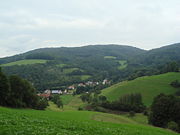
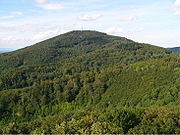
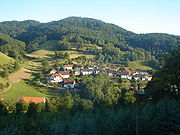
Over 600 m
- Katzenbuckel (626 m; lookout tower), Neckar-Odenwald-KreisNeckar-Odenwald-KreisNeckar-Odenwald-Kreis is a district in the north of Baden-Württemberg, Germany. Neighboring districts are Main-Tauber-Kreis, Hohenlohe, Heilbronn, Rhein-Neckar-Kreis, Odenwaldkreis Hesse and Landkreis Miltenberg Bavaria...
, Baden-WürttembergBaden-WürttembergBaden-Württemberg is one of the 16 states of Germany. Baden-Württemberg is in the southwestern part of the country to the east of the Upper Rhine, and is the third largest in both area and population of Germany's sixteen states, with an area of and 10.7 million inhabitants... - Neunkircher Höhe (605 m; Kaiser Tower), Bergstraße district, HesseHesseHesse or Hessia is both a cultural region of Germany and the name of an individual German state.* The cultural region of Hesse includes both the State of Hesse and the area known as Rhenish Hesse in the neighbouring Rhineland-Palatinate state...
Over 450 m
- Hardberg (593 m), Bergstraße district, Hesse
- Stiefelhöhe (589 m), Hesse/Baden-Württemberg border
- Tromm (577 m; lookout tower), Bergstraße district, Hesse
- Krehberg (576 m; with Krehberg transmitter), Bergstraße district, Hesse
- Königstuhl (567.8 m; observatoryObservatoryAn observatory is a location used for observing terrestrial or celestial events. Astronomy, climatology/meteorology, geology, oceanography and volcanology are examples of disciplines for which observatories have been constructed...
, funicular railway), HeidelbergHeidelberg-Early history:Between 600,000 and 200,000 years ago, "Heidelberg Man" died at nearby Mauer. His jaw bone was discovered in 1907; with scientific dating, his remains were determined to be the earliest evidence of human life in Europe. In the 5th century BC, a Celtic fortress of refuge and place of...
, Baden-Württemberg - Krähberg (555 m), OdenwaldkreisOdenwaldkreisThe Odenwaldkreis is a Kreis in the south of Hesse, Germany. Neighboring districts are Darmstadt-Dieburg, Miltenberg,Neckar-Odenwald-Kreis, Rhein-Neckar-Kreis and Kreis Bergstraße. Odenwaldkreis belongs to the Rhine Neckar Area.-History:...
, Hesse - Kinzert (554 m), Neckar-Odenwald-KreisNeckar-Odenwald-KreisNeckar-Odenwald-Kreis is a district in the north of Baden-Württemberg, Germany. Neighboring districts are Main-Tauber-Kreis, Hohenlohe, Heilbronn, Rhein-Neckar-Kreis, Odenwaldkreis Hesse and Landkreis Miltenberg Bavaria...
, Baden-Württemberg - Weißer Stein (550 m; lookout tower), Rhein-Neckar-KreisRhein-Neckar-KreisRhein-Neckar-Kreis is a district in the northwest of Baden-Württemberg, Germany. Neighboring districts are Bergstraße, Odenwaldkreis, Neckar-Odenwald, Heilbronn, Karlsruhe, district-free Speyer, the Rhein-Pfalz-Kreis, and district-free Mannheim and Heidelberg.-History:The district was created in...
, Baden-Württemberg - Hohe Warte (548 m), Rhein-Neckar-Kreis, Baden-Württemberg
- Spessartskopf (547 m), Bergstraße district, Hesse
- Falkenberg (546 m), Odenwaldkreis, Hesse
- Waldskopf (538 m), GorxheimertalGorxheimertalGorxheimertal is a community in the Bergstraße district in Hesse, Germany. It is in the Odenwald and the Rhine Neckar Area.-Location:The community lies along the length of the Grundelbach valley in the Odenwald...
-Trösel, Bergstraße district, Hesse - Das Buch (535.30 m; near Lindenfels), Bergstraße district, Hesse
- Wagenberg (535 m), Bergstraße district, Hesse
- Eichelberg (526 m; lookout tower), Rhein-Neckar-Kreis, Baden-Württemberg
- Götzenstein (522 m), Bergstraße district, Hesse
- Melibokus („Malschen“) (517.40 m), Bergstraße district, Hesse
- Morsberg (517 m), Odenwaldkreis, Hesse
- Felsberg (514 m; with Felsenmeer), Bergstraße district, Hesse
- Knodener Kopf (511.20 m), Bergstraße district, Hesse
- Wannenberg (482 m), Miltenberg districtMiltenberg (district)Miltenberg is an administrative district in Bavaria, Germany. It is bounded by the city of Aschaffenburg, the districts of Aschaffenburg and Main-Spessart, and the states of Baden-Württemberg and Hesse .-History:During the Middle Ages there was continuous...
, BavariaBavariaBavaria, formally the Free State of Bavaria is a state of Germany, located in the southeast of Germany. With an area of , it is the largest state by area, forming almost 20% of the total land area of Germany... - Daumberg (462 m), Gorxheimertal-Trösel, Bergstraße district, Hesse
Over 300 m
- Heiligenberg (445 m), Heidelberg, Baden-Württemberg
- Knorz (404 m; near Lautern), Bergstraße district, Hesse
- Otzberg (367 m; with Veste Otzberg), Darmstadt-DieburgDarmstadt-DieburgDarmstadt-Dieburg is a Kreis in the south of Hesse, Germany. Neighboring districts are Offenbach, Aschaffenburg, Miltenberg, Odenwaldkreis, Bergstraße, Groß-Gerau, and the district-free city of Darmstadt, which it surrounds.-History:...
, Hesse - Auerberg (339.70 m; with Schloss Auerbach), Bergstraße district, Hesse
- Breuberg (306 m; with Breuberg Castle), Odenwaldkreis, Hesse
Flowing water
Countless streams rise in the Odenwald, the longest of which are the following:
- Weschnitz (60 km), tributary to the Rhine
- Mümling (50 km), tributary to the Main
- Gersprenz (47 km), tributary to the Main
- Lauter (43 km), tributary to the Rhine
- Erf (40 km), tributary to the Main
- Elz (Elzbach) (34 km), tributary to the Neckar
- Finkenbach (20.5 km), joins the Ulfenbach in Hirschhorn, runs to the Laxbach, tributary to the Neckar
- Ulfenbach (19.1 km), joins the Finkenbach in Hirschhorn, runs to the Laxbach, tributary to the Neckar
- Grundelbach, (10 km), flows from Trösel to Weinheim
- Modau (42 km), tributary to the Rhine
- Mud (24 km), tributary to the Main
- Steinach (22 km), tributary to the Neckar
Standing water
There are a few bodies of standing water in the Odenwald, among which are the following:- the Marbach ReservoirReservoirA reservoir , artificial lake or dam is used to store water.Reservoirs may be created in river valleys by the construction of a dam or may be built by excavation in the ground or by conventional construction techniques such as brickwork or cast concrete.The term reservoir may also be used to...
- the Eutersee
Political divisions

Districts (with district seats)
- Bergstraße district (HeppenheimHeppenheimHeppenheim is the seat of Bergstraße district in Hesse, Germany, lying on the Bergstraße on the edge of the Odenwald.- Location :...
) - Darmstadt-DieburgDarmstadt-DieburgDarmstadt-Dieburg is a Kreis in the south of Hesse, Germany. Neighboring districts are Offenbach, Aschaffenburg, Miltenberg, Odenwaldkreis, Bergstraße, Groß-Gerau, and the district-free city of Darmstadt, which it surrounds.-History:...
(DieburgDieburgDieburg is a town in southern Hessen, Germany. It was formerly the seat of the district of Dieburg, but is now part of the district of Darmstadt-Dieburg.-History:...
, administration in DarmstadtDarmstadtDarmstadt is a city in the Bundesland of Hesse in Germany, located in the southern part of the Rhine Main Area.The sandy soils in the Darmstadt area, ill-suited for agriculture in times before industrial fertilisation, prevented any larger settlement from developing, until the city became the seat...
-Kranichstein) - Main-Tauber-Kreis (TauberbischofsheimTauberbischofsheimTauberbischofsheim is a German town in the north-east of Baden-Württemberg on the river Tauber with a population of about 13,000. It is the capital of the Main-Tauber district....
) - Miltenberg districtMiltenberg (district)Miltenberg is an administrative district in Bavaria, Germany. It is bounded by the city of Aschaffenburg, the districts of Aschaffenburg and Main-Spessart, and the states of Baden-Württemberg and Hesse .-History:During the Middle Ages there was continuous...
(MiltenbergMiltenbergMiltenberg is the seat of the like-named district in the Regierungsbezirk of Lower Franconia in Bavaria, Germany.- Location :...
) - Neckar-Odenwald-KreisNeckar-Odenwald-KreisNeckar-Odenwald-Kreis is a district in the north of Baden-Württemberg, Germany. Neighboring districts are Main-Tauber-Kreis, Hohenlohe, Heilbronn, Rhein-Neckar-Kreis, Odenwaldkreis Hesse and Landkreis Miltenberg Bavaria...
(MosbachMosbachMosbach is the capital of the Neckar-Odenwald district in the north of Baden-Württemberg, Germany, about 58 km east of Heidelberg. Its geographical position is 49.21'N 9.9'E....
) - OdenwaldkreisOdenwaldkreisThe Odenwaldkreis is a Kreis in the south of Hesse, Germany. Neighboring districts are Darmstadt-Dieburg, Miltenberg,Neckar-Odenwald-Kreis, Rhein-Neckar-Kreis and Kreis Bergstraße. Odenwaldkreis belongs to the Rhine Neckar Area.-History:...
(ErbachErbach im Odenwald-Location:The town lies in the Odenwald at elevations between 200 and 560 m in the valley of the Mümling.-Neighbouring communities:Erbach borders in the north on the town of Michelstadt, in the east on the market town of Kirchzell , in the south on the community of Hesseneck and the town of...
) - Rhein-Neckar-KreisRhein-Neckar-KreisRhein-Neckar-Kreis is a district in the northwest of Baden-Württemberg, Germany. Neighboring districts are Bergstraße, Odenwaldkreis, Neckar-Odenwald, Heilbronn, Karlsruhe, district-free Speyer, the Rhein-Pfalz-Kreis, and district-free Mannheim and Heidelberg.-History:The district was created in...
(HeidelbergHeidelberg-Early history:Between 600,000 and 200,000 years ago, "Heidelberg Man" died at nearby Mauer. His jaw bone was discovered in 1907; with scientific dating, his remains were determined to be the earliest evidence of human life in Europe. In the 5th century BC, a Celtic fortress of refuge and place of...
)
Transport and tourism
The Odenwald is known as a leisure destination easily accessible from the urban areas of MannheimMannheim
Mannheim is a city in southwestern Germany. With about 315,000 inhabitants, Mannheim is the second-largest city in the Bundesland of Baden-Württemberg, following the capital city of Stuttgart....
and Frankfurt
Frankfurt
Frankfurt am Main , commonly known simply as Frankfurt, is the largest city in the German state of Hesse and the fifth-largest city in Germany, with a 2010 population of 688,249. The urban area had an estimated population of 2,300,000 in 2010...
. It is known for its clean thin air and was once known for its health sanitariums. There are many marked hiking paths through the rural areas. Wild blueberries
Blueberry
Blueberries are flowering plants of the genus Vaccinium with dark-blue berries and are perennial...
, strawberries
Strawberry
Fragaria is a genus of flowering plants in the rose family, Rosaceae, commonly known as strawberries for their edible fruits. Although it is commonly thought that strawberries get their name from straw being used as a mulch in cultivating the plants, the etymology of the word is uncertain. There...
and mushroom
Mushroom
A mushroom is the fleshy, spore-bearing fruiting body of a fungus, typically produced above ground on soil or on its food source. The standard for the name "mushroom" is the cultivated white button mushroom, Agaricus bisporus; hence the word "mushroom" is most often applied to those fungi that...
s are to be found in the forests.
Roads
The planned extension to the Odenwaldautobahn, that is, the A 45
Bundesautobahn 45
is an autobahn in Germany, connecting Dortmund in the west with Aschaffenburg in the southwest. It is colloquially known by its byname Sauerlandlinie, which derives from the Sauerland, the landscape which said autobahn is running through between the cities of Hagen and Siegen. Many people think of...
(Dortmund
Dortmund
Dortmund is a city in Germany. It is located in the Bundesland of North Rhine-Westphalia, in the Ruhr area. Its population of 585,045 makes it the 7th largest city in Germany and the 34th largest in the European Union....
–Aschaffenburg
Aschaffenburg
Aschaffenburg is a city in northwest Bavaria, Germany. The town of Aschaffenburg is not considered part of the district of Aschaffenburg, but is the administrative seat.Aschaffenburg is known as the Tor zum Spessart or "gate to the Spessart"...
), was never realized. Nevertheless, all these Bundesstraße
Bundesstraße
Bundesstraße , abbreviated B, is the denotation for German and Austrian national highways.-Germany:...
n run through the Odenwald:
- B 27: MosbachMosbachMosbach is the capital of the Neckar-Odenwald district in the north of Baden-Württemberg, Germany, about 58 km east of Heidelberg. Its geographical position is 49.21'N 9.9'E....
- BuchenBuchenBuchen is a town in Germany Neckar-Odenwald district, in Baden-Württemberg, Germany. It is situated in the Odenwald low mountain range, 23 km northeast of Mosbach.-Geography:...
- TauberbischofsheimTauberbischofsheimTauberbischofsheim is a German town in the north-east of Baden-Württemberg on the river Tauber with a population of about 13,000. It is the capital of the Main-Tauber district.... - B 38: ReinheimReinheimReinheim is a town in the Darmstadt-Dieburg district, in Hesse, Germany. It is situated 14 km southeast of Darmstadt.-Twin towns - Sister cities:...
- Groß-BieberauGroß-BieberauGroß-Bieberau is a town in the Darmstadt-Dieburg district, in Hesse, Germany. It is situated 15 km southeast of Darmstadt. It has several sister cities, one of which is Millstadt, Illinois....
- BrensbachBrensbach-Neighbouring communities:Brensbach borders in the north on the towns of Groß-Bieberau and Reinheim and the community of Otzberg , in the east on the community of Höchst and the town of Bad König, in the south on the communities of Brombachtal and Reichelsheim and in the west on the communities of...
- ReichelsheimReichelsheimReichelsheim is the name of two communes in Hesse, Germany*Reichelsheim *Reichelsheim...
- Fürth - MörlenbachMörlenbachMörlenbach is a community in the Bergstraße district in southern Hesse, Germany.-Location:The community lies in the Odenwald some 25 km north of Heidelberg and about 30 km northeast of Mannheim, as well as lying 8 km southeast of Heppenheim...
- BirkenauBirkenau (Odenwald)Birkenau in the Odenwald is a community in the Bergstraße district in southern Hesse, Germany. Its nickname is Das Dorf der Sonnenuhren – “The Sundial Village”.-Location:...
- WeinheimWeinheimWeinheim is a town in the north west of the state of Baden-Württemberg in Germany with 43 000 inhabitants, approximately 15 km north of Heidelberg and 10 km northeast of Mannheim. Together with these cities, it makes up the Rhine-Neckar triangle... - B 45: Groß-UmstadtGroß-UmstadtGroß-Umstadt is a town in the district of Darmstadt-Dieburg in the Bundesland of Hesse in Germany. It is near Darmstadt and Frankfurt on the northern border of the Odenwald and is on the edge of the Frankfurt Rhein-Main Region. The highest point of the town is the Heidelberg .The population is...
- HöchstHöchst im OdenwaldHöchst im Odenwald is a community in the Odenwaldkreis in Hesse, Germany.-Location:Höchst lies 25 km east of Darmstadt, in the northern Odenwald at elevations between 175 and 400 m....
- Bad KönigBad KönigBad König is a town and resort in the central Odenwald in the Odenwaldkreis in Hesse, Germany, 29 km southeast of Darmstadt.- Neighbouring communities :...
- MichelstadtMichelstadtMichelstadt in the Odenwald is a town in the Odenwaldkreis in southern Hesse, Germany between Darmstadt and Heidelberg.- Location :Michelstadt is the biggest town in the Odenwaldkreis and borders on the district seat of Erbach....
- ErbachErbach-Places:*Erbach, a constituent community of Bad Camberg in Hesse*Erbach an der Donau, town in Baden-Württemberg**Erbach Castle, castle in Erbach an der Donau*Erbach im Odenwald, town in Hesse**Erbacher Schloss, castle in Erbach im Odenwald...
- BeerfeldenBeerfeldenBeerfelden is a town in the Odenwald in the Odenwaldkreis in Hesse, Germany, 28 km northeast of Heidelberg. The region around Beerfelden has for touristic reasons been dubbed the Beerfelder Land.-Location:...
- EberbachEberbachEberbach can refer to:* Eberbach , city on the river Neckar in Baden-Württemberg, Germany* Eberbach Abbey, Cistercian monastery in Germany* Eberbach-Seltz, commune of the Bas-Rhin département in FrancePeople:... - B 47: BensheimBensheimBensheim is a town in the Bergstraße district in southern Hesse, Germany. Bensheim lies on the Bergstraße and at the edge of the Odenwald mountains while at the same time having an open view over the Rhine plain...
- LindenfelsLindenfelsLindenfels is a town in the Bergstraße district in Hesse, Germany.- Location :The climatic spa, also known as the “Pearl of the Odenwald”, lies in the Odenwald in southern Hesse and is nestled in a mountain landscape with a great deal of woodland....
- ReichelsheimReichelsheimReichelsheim is the name of two communes in Hesse, Germany*Reichelsheim *Reichelsheim...
- MichelstadtMichelstadtMichelstadt in the Odenwald is a town in the Odenwaldkreis in southern Hesse, Germany between Darmstadt and Heidelberg.- Location :Michelstadt is the biggest town in the Odenwaldkreis and borders on the district seat of Erbach....
- AmorbachAmorbachAmorbach is a town in the Miltenberg district in the Regierungsbezirk of Lower Franconia in Bavaria, Germany, with some 4,100 inhabitants .- Location :... - B 426: DarmstadtDarmstadtDarmstadt is a city in the Bundesland of Hesse in Germany, located in the southern part of the Rhine Main Area.The sandy soils in the Darmstadt area, ill-suited for agriculture in times before industrial fertilisation, prevented any larger settlement from developing, until the city became the seat...
- MühltalMühltalMühltal is a municipality in the district of Darmstadt-Dieburg, in Hesse, Germany. It is situated 6 km southeast of Darmstadt.-Notable people:*Karl Ferdinand Abt -Nazi politician*Johann Konrad Dippel -theologian and alchemist...
- Ober-RamstadtOber-RamstadtOber-Ramstadt is a town in the Darmstadt-Dieburg district, in Hesse, Germany. It is situated 9 km southeast of Darmstadt. As of 2006, its population was 15,196.-Location:...
- ReinheimReinheimReinheim is a town in the Darmstadt-Dieburg district, in Hesse, Germany. It is situated 14 km southeast of Darmstadt.-Twin towns - Sister cities:...
- OtzbergOtzbergOtzberg is a municipality in the district of Darmstadt-Dieburg, located in the Odenwald. It was founded in 1972 by the merger of six former independent municipalities....
- Groß-UmstadtGroß-UmstadtGroß-Umstadt is a town in the district of Darmstadt-Dieburg in the Bundesland of Hesse in Germany. It is near Darmstadt and Frankfurt on the northern border of the Odenwald and is on the edge of the Frankfurt Rhein-Main Region. The highest point of the town is the Heidelberg .The population is...
- HöchstHöchst im OdenwaldHöchst im Odenwald is a community in the Odenwaldkreis in Hesse, Germany.-Location:Höchst lies 25 km east of Darmstadt, in the northern Odenwald at elevations between 175 and 400 m....
- BreubergBreubergBreuberg is a town in the Odenwaldkreis in Hesse, Germany, 28 km east of Darmstadt, and 20 km southwest of Aschaffenburg.- Neighbouring communities :...
- ObernburgObernburgObernburg am Main is a town in the Miltenberg district in the Regierungsbezirk of Lower Franconia in Bavaria, Germany.- Location :... - B 460: HeppenheimHeppenheimHeppenheim is the seat of Bergstraße district in Hesse, Germany, lying on the Bergstraße on the edge of the Odenwald.- Location :...
- Fürth - MossautalMossautalMossautal in the Odenwald is a community and a state-recognized health resort in the Odenwaldkreis in Hesse, Germany.-Location:The community lies at elevations of between 300 and 500 m above sea level....
- Hüttenthal
Furthermore, the Nibelungenstraße and the Siegfriedstraße run through the Odenwald, partly along the roads listed above.
Railways
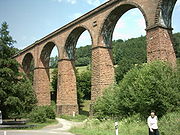
- Odenwald Railway from DarmstadtDarmstadtDarmstadt is a city in the Bundesland of Hesse in Germany, located in the southern part of the Rhine Main Area.The sandy soils in the Darmstadt area, ill-suited for agriculture in times before industrial fertilisation, prevented any larger settlement from developing, until the city became the seat...
or HanauHanauHanau is a town in the Main-Kinzig-Kreis, in Hesse, Germany. It is located 25 km east of Frankfurt am Main. Its station is a major railway junction.- Geography :...
by way of Wiebelsbach-Heubach to EberbachEberbach (Baden)Eberbach is a town in Germany, in northern Baden-Württemberg, located 33 km east of Heidelberg. It belongs to the Rhein-Neckar-Kreis. Its sister city is Ephrata, United States.- Location :...
, opened in 1882, since December 2005 run with modern ItinoBombardier ItinoBombardier Itino Y31/Y32 is an diesel multiple unit manufactured by Bombardier Transportation, originally developed by Adtranz. It has two or three cars and is capable of 140 –160 km/h. 40 units have been built and 17 more are on order. It is in service in Germany and Sweden.-Germany:In...
trains - Weschnitz Valley RailwayWeschnitz Valley RailwayThe Weschnitz Valley Railway is a railway line in Germany that runs from Weinheim an der Bergstraße the in the valley of the River Weschnitz to Fürth im Odenwald.- External links :* * * *...
from WeinheimWeinheimWeinheim is a town in the north west of the state of Baden-Württemberg in Germany with 43 000 inhabitants, approximately 15 km north of Heidelberg and 10 km northeast of Mannheim. Together with these cities, it makes up the Rhine-Neckar triangle...
to FürthFürth, HesseFürth is a community and a state-recognized recreational resort in the Bergstraße district in Hesse, Germany.- Location :The community lies in the UNESCO Geo-Naturpark Bergstraße-Odenwald on the Weschnitz, a small river that empties into Rhine near Biblis...
, opened in 1895 - Überwald Railway from MörlenbachMörlenbachMörlenbach is a community in the Bergstraße district in southern Hesse, Germany.-Location:The community lies in the Odenwald some 25 km north of Heidelberg and about 30 km northeast of Mannheim, as well as lying 8 km southeast of Heppenheim...
by way of Wald-MichelbachWald-MichelbachWald-Michelbach is a community in the Bergstraße district in Hesse, Germany.Through Wald-Michelbach runs the now disused Überwaldbahn .-Hardberg:...
to Wahlen, opened in 1901, abandoned in 1996 - Hetzbach–Beerfelden line from Hetzbach to BeerfeldenBeerfeldenBeerfelden is a town in the Odenwald in the Odenwaldkreis in Hesse, Germany, 28 km northeast of Heidelberg. The region around Beerfelden has for touristic reasons been dubbed the Beerfelder Land.-Location:...
, opened in 1904, abandoned in 1954 - Mosbach–Mudau line (locally known as the Entenmörder – “Duck Murderer”) from MosbachMosbachMosbach is the capital of the Neckar-Odenwald district in the north of Baden-Württemberg, Germany, about 58 km east of Heidelberg. Its geographical position is 49.21'N 9.9'E....
to MudauMudauMudau is a municipality in the Neckar-Odenwald district, Baden-Württemberg, Germany. it has 5,099 inhabitants.-Geography:Mudau lies in the southeastern Odenwald mountains between the Neckar and Main rivers, 75 km southeast of Frankfurt am Main and 40 km northeast of Heidelberg...
, former 1000 mm narrow-gauge railwayNarrow gaugeA narrow gauge railway is a railway that has a track gauge narrower than the of standard gauge railways. Most existing narrow gauge railways have gauges of between and .- Overview :...
, opened in 1905, abandoned in 1973, since 1980 right-of-way has been converted into a cycling path - Neckar Valley RailwayNeckar Valley RailwayThe Neckar Valley Railway, or Neckar Valley Main Line is a railway line from Heidelberg via Eberbach and Mosbach to Bad Friedrichshall-Jagstfeld in southwestern Germany...
from HeidelbergHeidelberg-Early history:Between 600,000 and 200,000 years ago, "Heidelberg Man" died at nearby Mauer. His jaw bone was discovered in 1907; with scientific dating, his remains were determined to be the earliest evidence of human life in Europe. In the 5th century BC, a Celtic fortress of refuge and place of...
by way of EberbachEberbach (Baden)Eberbach is a town in Germany, in northern Baden-Württemberg, located 33 km east of Heidelberg. It belongs to the Rhein-Neckar-Kreis. Its sister city is Ephrata, United States.- Location :...
and Mosbach to Bad Friedrichshall-JagstfeldBad Friedrichshall-Jagstfeld stationBad Friedrichshall-Jagstfeld station is a regionally important railway junction and a former border station in the city of Bad Friedrichshall in the German state of Baden-Württemberg. The modern Elsenz Valley Railway and Neckar Valley Railway branch from the Franconia Railway here...
, opened in 1879 - Neckarelz–Osterburken line, opened in 1866 as part of the Baden Odenwaldbahn
- Madonnenland Railway from SeckachSeckachSeckach is a town in the district of Neckar-Odenwald-Kreis, in Baden-Württemberg, Germany.-References:...
to MiltenbergMiltenbergMiltenberg is the seat of the like-named district in the Regierungsbezirk of Lower Franconia in Bavaria, Germany.- Location :... - Gersprenz Valley Railway from ReinheimReinheimReinheim is a town in the Darmstadt-Dieburg district, in Hesse, Germany. It is situated 14 km southeast of Darmstadt.-Twin towns - Sister cities:...
to ReichelsheimReichelsheimReichelsheim is the name of two communes in Hesse, Germany*Reichelsheim *Reichelsheim...
, opened in 1887 and abandoned by 1963
Sightseeing
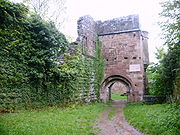
- In Hainstadt, Hesse (a constituent community of BreubergBreubergBreuberg is a town in the Odenwaldkreis in Hesse, Germany, 28 km east of Darmstadt, and 20 km southwest of Aschaffenburg.- Neighbouring communities :...
) in the Mümling valley is a quarryQuarryA quarry is a type of open-pit mine from which rock or minerals are extracted. Quarries are generally used for extracting building materials, such as dimension stone, construction aggregate, riprap, sand, and gravel. They are often collocated with concrete and asphalt plants due to the requirement...
which has been turned into a climbingClimbingClimbing is the activity of using one's hands and feet to ascend a steep object. It is done both for recreation and professionally, as part of activities such as maintenance of a structure, or military operations.Climbing activities include:* Bouldering: Ascending boulders or small...
facility by the Odenwälder Kletterfreunde (“Odenwald Climbing Friends”). There is also a climbing path secured by wire cables. The Odenwald Climbing Friends take care of the paths. The quarry also lies in the DAV’s (Deutsche Alpenverein e. V. – a mountain climbing club) DarmstadtDarmstadtDarmstadt is a city in the Bundesland of Hesse in Germany, located in the southern part of the Rhine Main Area.The sandy soils in the Darmstadt area, ill-suited for agriculture in times before industrial fertilisation, prevented any larger settlement from developing, until the city became the seat...
Section feeder area.
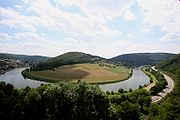
- Beneath the 514 m-high Felsberg and north of LautertalLautertal, HesseLautertal is a community in the Bergstraße district in the Hessian Odenwald in Germany that came into being with the merger of several former communities.-Location:...
-Reichenbach is found a Felsenmeer – literally “cliff sea” – consisting of many weathered stones strewn about the ground which have fallen down from the cliff after having come loose from erosion. The RomansAncient RomeAncient Rome was a thriving civilization that grew on the Italian Peninsula as early as the 8th century BC. Located along the Mediterranean Sea and centered on the city of Rome, it expanded to one of the largest empires in the ancient world....
used it as a stone quarry. - In Eberstadt, a constituent community of BuchenBuchenBuchen is a town in Germany Neckar-Odenwald district, in Baden-Württemberg, Germany. It is situated in the Odenwald low mountain range, 23 km northeast of Mosbach.-Geography:...
, one of southern Germany’s most important dripstone caves was discovered in 1971. It is open to the public. - Around the Katzenbuckel runs the Kristall-Lehrpfad (“Crystal Teaching Path”), which graphically shows the volcanic development in the Odenwald.
- From Höchst im Odenwald snakes the Obrunnschlucht (gorge) as a romantic fairytale path towards Rimhorn with many model buildings (palaces, castles and mills) along the valley.
- The Odenwald is threaded with a network of more than 10 000 km of hiking trails.
- Because the highways have so many curves, the Odenwald is a popular outing destination for motorcyclists.
Music

- Es steht ein Baum im Odenwald (“There Stands a Tree in the Odenwald”)
- Tief im Odenwald (“Deep in the Odenwald”)
- Der Bauer aus dem Odenwald (“The Farmer from the Odenwald”)
- Es regt sich was im Odenwald (“Things Are Stirring in the Odenwald”)
See also
- Hessian dialectsHessian dialectsHessian is a West Central German group of dialects of the German language in the central German state of Hesse. The dialect most similar to Hessian is Palatinate German of the Rhine Franconian sub-family...
- Historical territorial allegiances: Electoral Palatinate | Archbishopric of MainzArchbishopric of MainzThe Archbishopric of Mainz or Electorate of Mainz was an influential ecclesiastic and secular prince-bishopric in the Holy Roman Empire between 780–82 and 1802. In the Roman Catholic Church hierarchy, the Archbishop of Mainz was the primas Germaniae, the substitute of the Pope north of the Alps...
| Landgraviate of HesseLandgraviate of HesseThe Landgraviate of Hesse was a Landgraviate of the Holy Roman Empire. It existed as a unity from 1264 to 1567, when it was divided between the sons of Philip I, Landgrave of Hesse.-History:...
| Grand Duchy of HesseGrand Duchy of HesseThe Grand Duchy of Hesse and by Rhine , or, between 1806 and 1816, Grand Duchy of Hesse —as it was also known after 1816—was a member state of the German Confederation from 1806, when the Landgraviate of Hesse-Darmstadt was elevated to a Grand Duchy, until 1918, when all the German...
| People's State of Hesse | BadenBadenBaden is a historical state on the east bank of the Rhine in the southwest of Germany, now the western part of the Baden-Württemberg of Germany....
Monographs and anthologies
- Marco Lichtenberger: Saurier aus dem Odenwald. Jens Seeling Verlag. Frankfurt 2007. ISBN 3-938973-04-8
- Winfried Wackerfuss (publisher): Zu Kultur und Geschichte des Odenwaldes. 2. unveränderte Auflage 1982. Breuberg-Bund, Breuberg-Neustadt 1982. ISBN 3-922903-01-0
- Otmar A. Geiger: Sagenhafter Odenwald. Ein Führer durch das Reich der Nibelungen zwischen Worms und Würzburg. Schimper, Schwetzingen 2000. ISBN 3-87742-152-0
- Georg Bungenstab (publisher): Wälder im Odenwald - Wald für die Odenwälder. Dokumente aus 150 Jahren Eberbacher Forstgeschichte. Staatliches Forstamt Eberbach, Eberbach 1999, 288 S.
- Heinz Bischof: Odenwald. 3., überarbeitete Auflage. Goldstadtverlag, Pforzheim 2004. ISBN 3-89550-313-4
- Thomas Biller/Achim Wendt: Burgen und Schlösser im Odenwald. Ein Führer zu Geschichte und Architektur. Schnell & Steiner, Regensburg 2005. ISBN 3-7954-1711-2
- Andreas Stieglitz: Wandern im Odenwald und an der Bergstraße. Aus der Reihe DuMont aktiv. DuMont Reiseverlag, Ostfildern 2005. ISBN 3-7701-5015-5.
- Seipel, Herbert Stephan: Faszination Odenwald. Eine Bilderreise zur Kulturgeschichte des Odenwaldes. Verlag Regionalkultur, Ubstadt-Weiher 2004. ISBN 978-3-89735-140-0
- Keller, Dieter/Keller, Uwe/Türk, Rainer: Der Odenwald zwischen Himmel und Erde. Verlag Regionalkultur, Ubstadt-Weiher 2003. ISBN 978-3-89735-187-5
Periodicals
- Breuberg-Bund (publisher): Beiträge zur Erforschung des Odenwaldes und seiner Randlandschaften. Breuberg-Bund, Breuberg-Neustadt 1977 ff.
- Breuberg-Bund (publisher): Der Odenwald. Vierteljahreszeitschrift des Breuberg-Bundes mit Beiträgen zur Geschichte, Volkskunde, Kunstgeschichte und Geographie des Odenwaldes und seiner Randlandschaften. Breuberg-Bund, Breuberg-Neustadt 1953 ff.
- Kreisarchiv des Odenwaldkreises (publisher): Gelurt. Odenwälder Jahrbuch für Kultur und Geschichte. Odenwaldkreis, Erbach 1994 ff.
- Arbeitsgemeinschaft der Geschichts- und Heimatvereine im Kreis Bergstrasse (publisher): Geschichtsblätter Kreis Bergstraße. Laurissa, Lorsch 1971 ff.
The Odenwald in Literature
- Adolf Schmitthenner: Das deutsche Herz. 3. Auflage. Stadt Hirschhorn, Hirschhorn, 1999. ISBN 3-927409-00-6 (first edition 1927)
- Werner Bergengrün: Das Buch Rodenstein. 3. Auflage. Insel, Frankfurt am Main 2002. ISBN 3-458-33493-9 (first edition 1908)

